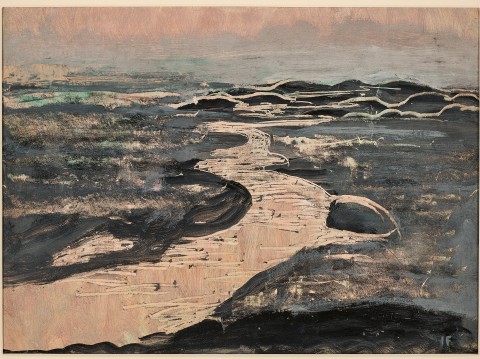The river, 1934
Ian Fairweather
oil on cardboard
39.0 x 53.0 cm
signed lower right with initials: IF
Macquarie Galleries, Sydney
Nicholas G. Andrews, Sydney
Alan Geddes, Sydney
Lawsons, Sydney, 16 May 1989, lot 88 (as ‘Youngtse River [sic]’)
Private collection
Sotheby's, Melbourne, 5 May 2003, lot 115 (as ‘Yangtse River [sic]’)
Private collection
Niagara Galleries, Melbourne (label attached verso)
Private collection, Melbourne, acquired from the above in March 2004
Show of Sixes, Macquarie Galleries, Sydney, 8 – 20 February 1956, cat. 6
Summer Collection of Works by Eminent Australian Artists, Irving Fine Art, Sydney, 5 January – 3 February 1990 (as ‘Yangtse River [sic], c.1945 – 47’)
Blue chip VI: the collector's exhibition, Niagara Galleries, Melbourne, 2 – 27 March 2004, cat. 15 (illus. in exhibition catalogue, p. 17)
Irving Fine Art advertisement, Art and Australia, Fine Arts Press Pty Limited, Sydney, vol. 27, no, 2, 1989, p. 188 (illus.)
‘…each painting asks a question, none disclose the answer.’1
Described by Murray Bail as ‘the least parochial of Australian painters, an artist of exceptional force and originality,’2 Ian Fairweather remains one of the most enigmatic figures of twentieth-century Australian modernism. An expressive fusion of abstraction and calligraphic mark-making, his distinctive visual language set him apart from his contemporaries and quickly drew widespread admiration from peers such as Russell Drysdale, Margaret Olley and Donald Friend, as well as critical recognition from leading artworld figures including Robert Hughes, who famously camped overnight outside Sydney’s Macquarie Galleries in 1962 to secure a Fairweather painting for his personal collection.
As a ‘itinerant, escapist utopian’3, Fairweather’s life was defined by endless movement and solitude. His adventures through Europe, Asia, and the Pacific not only shaped his worldview but importantly, became the impetus for his art – as biographer Murray Bail observed, Fairweather’s journeys ‘wander through his art like a Chinese line,’4 with each work becoming a distillation of experience and memory rather than a literal depiction of place. Of all his travels, undoubtedly none were as formative as his years in China during the 1930s where, immersed in both the dynamism of Shanghai and the meditative calm of smaller towns such as Huzhou, Hangzhou and Suzhou, Fairweather absorbed the philosophies of Chinese painting and calligraphy. Such experiences profoundly informed his later abstraction—his brushwork echoing the rhythm and restraint of East Asian aesthetics, yet simultaneously capturing the spiritual stillness he encountered there.
Nearly two decades later, after enduring many years of peripeteias and hardship, in 1953 Fairweather made his way back to Bribie Island, off the Queensland coast, where for the rest of his life, he would live in a pair of huts built with materials salvaged from the surrounding bush. Ironically, it was on this remote desolate island that he finally found a measure of stability and, for the first time since the outbreak of the Second World War, was able to establish a home (albeit austere) and dedicate himself wholly to painting. Isolated but creatively fulfilled, Fairweather worked from memory and from the sketches he had carried with him, drawing upon a mind crowded with vivid impressions of his travels. ‘I paint for myself,’ he mused, ‘and have no sense of mission, nor do I feel any compulsion to communicate, though naturally I am pleased when it seems I have done so.’5
A compelling example from this period, The river, c.1954 was most likely inspired by the artist’s recollections of Huzhou, in the Yangtze River delta north of Hangzhou. As was his custom, Fairweather sent the painting to Macquarie Galleries devoid of notes, leaving the choice of title to be assigned by the gallery’s directors when it was exhibited in the annual Show of Sixes in 1956. Though abstracted in part, the composition retains an overall connection to landscape representation with its pale, winding river moving sinuously through a network of loosely drawn mountains and amorphous forms, evoking not one specific place but arguably, a composite memory of several —Huzhou, Suzhou, and possibly even Queensland. Thus, fusing memory, place and spiritual inquiry, indeed such paintings from this period unfold over the support’s surface like a stream of consciousness or ‘way of meditation’6 – betraying distant impressions of Chinese calligraphy, Aboriginal rock painting, and European Post-Impressionism.
For, as Murray Bail elucidates, Fairweather’s paintings are ‘essentially ‘written’ by his own experiences’7 – each a rich palimpsest of textured surfaces and allusions that inevitably reveals the inner depth or spirituality so fundamental to his highly idiosyncratic vision. The culmination of a lifelong quest to attain or comprehend some deeper existential meaning, such contemplative creations of Fairweather’s maturity powerfully transcend time or circumstance to elucidate emotions universal to all human experience. As Laurie Thomas, appreciating the originality of Fairweather’s legacy, reflected at the time: ‘He paints what he sees. But what he sees nobody else had seen until now.’8
1. Ian Fairweather, cited in Fisher, T. , The Drawings of Ian Fairweather, National Gallery of Australia, Canberra, 1997, p. 4
2. Bail, M., Ian Fairweather, Bay Books, Sydney, 1981, p. 220
3. Fisher, op. cit., p.5
4. ibid.
5. Ian Fairweather, cited in Abbott-Smith, N., Ian Fairweather: Profile of a painter, University of Queensland Press, Brisbane, 1978, p. xi
6. Hughes, R., The Art of Australia, revised edition, Penguin Books, Victoria, 1970, p. 290
Veronica Angelatos
7. Bail, op. cit.
8. Thomas, L., ‘Ian Fairweather’, Art and Australia, Sydney, vol. 1, no. 1, May 1963, p. 35
